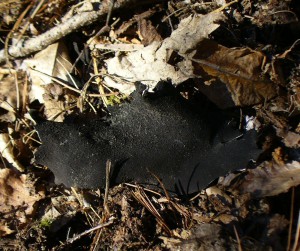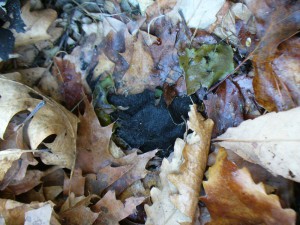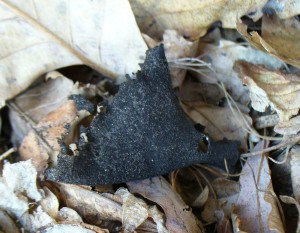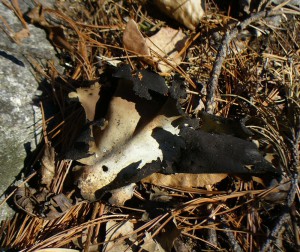This part of the story actually happens before the lye testing in Part Five, but to me it is the climax of the whole story, so I saved it until the end.
As the ground stayed bare this winter, I continued to see lots more (probably) Flavoparmelia caperata lying on the ground, and other lichens. It made me wonder how much usually gets buried under the snow. Does it usually get crushed and decompose? If it had been a regular snowy winter, I’d never even know it was there. Which leads me to….
Part Six: Non-Snowy Woods on the First of February
The first of February was glorious and warm and sunny. To celebrate the day, I went for a longer walk than usual. A hike. There was not a patch of snow on the ground anywhere, only occasional ice. Just as I was thinking about how happy I was that this non-snowy winter enabled me to learn more about lichens, I noticed a lot of umbilicates growing on a rock face that I’d never really noticed before. I scrabbled over to check at the base of the rocks for any fallen pieces. There was an incredible, astonishing abundance! I felt like I was in a fairy tale; I’d been thinking about how awesome lichens are, and then ta-da there were tons of them. Magic. And not just any lichens, the awesomest ones.
I filled both my pockets with loose pieces from the ground, but there was way more than my pockets could hold. A blissful day and a blissful foraging treat.
Here are some photos. Some pieces were right on the ground, and some were hidden under the leaves. The underside of these umbilicates is velvety and black. The top is greenish, olive, or brownish. They are sometimes called “rock tripe,” hence the labels on the photos (if you hover over or click on an image it tells you the title of the photo).
I went back to the same spot on February 6th (another glorious day) with a gallon sized zip lock bag, and filled that also.
The discovery of this abundance made me wonder whether this much falls off every winter, or whether more pieces than usual broke off this year because of the weird (comparatively warm and dry) weather. Would I find this much again another winter? I’m not sure, but I don’t think so. I think this weird winter was special.




